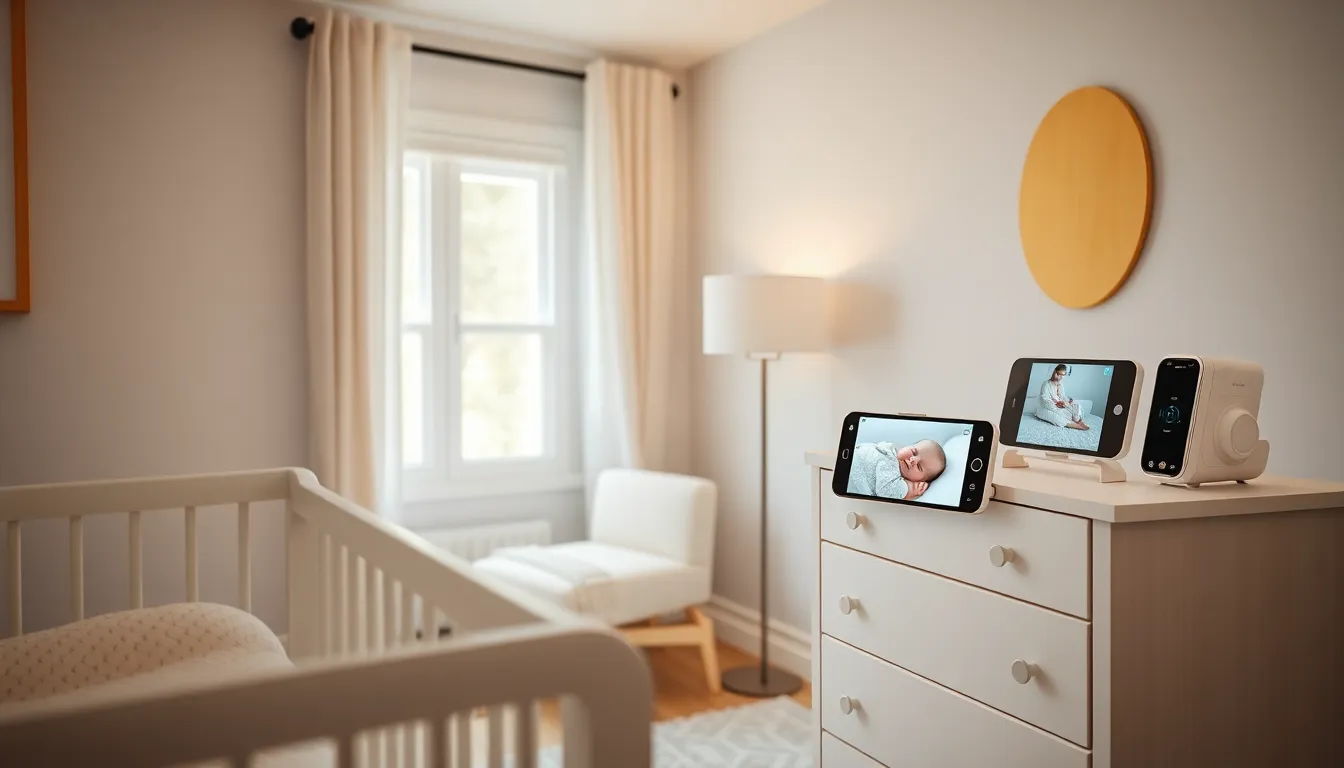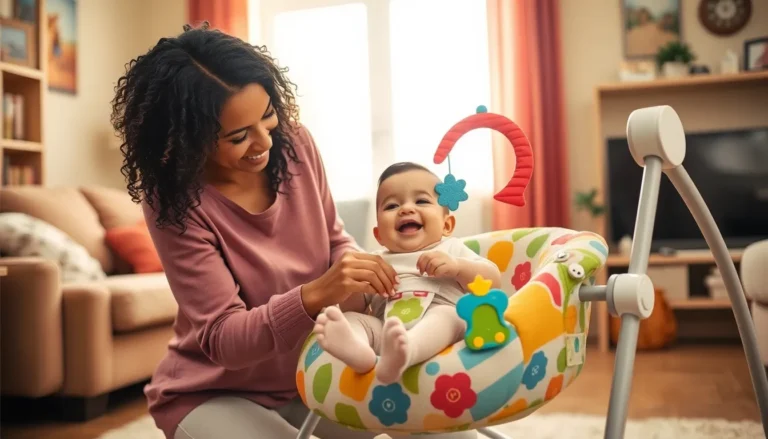In the world of parenting, peace of mind is priceless. Enter the baby monitor—a trusty sidekick that lets parents keep an eye (and ear) on their little ones without playing a game of hide-and-seek. With a plethora of options available, choosing the right baby monitor can feel like picking a favorite child—impossible!
Table of Contents
ToggleOverview of Baby Monitors
Baby monitors serve as essential tools for modern parenting. Different types of monitors cater to various needs, ensuring that parents can select features that best suit their lifestyles. Audio monitors provide sound only, allowing parents to listen in without visual feedback. Video monitors, on the other hand, enable visual observation, which can be comforting for parents wanting to keep an eye on their baby.
Smart monitors offer advanced features, often connecting to Wi-Fi for remote access via smartphones. Some models even include sleep tracking and environmental sensors, monitoring room temperature and humidity. Various brands present varied functionalities, making comparisons crucial for informed decisions.
Battery life affects usability. Many parents prefer monitors with long-lasting batteries to avoid frequent recharging. Also, the range of the monitor plays a critical role, especially for larger homes. Select monitors provide extensive range capabilities, ensuring parents can move throughout their spaces.
In terms of pricing, baby monitors range significantly. Budget-friendly models focus on essential features, while high-end options incorporate advanced technology. Parents often weigh the importance of features against their budget constraints.
Choosing the right baby monitor involves considering these diverse elements. Each family’s unique situation influences their final decision on a monitor. Familiarizing oneself with product specifications and user reviews offers deeper insights. Prioritization of needs simplifies the selection process, enabling parents to find the best fit for their family.
Types of Baby Monitors

Understanding the various types of baby monitors helps parents choose the right fit for their needs. Each category offers distinct features to enhance child monitoring.
Audio Baby Monitors
Audio baby monitors focus solely on sound transmission. These monitors consist of a transmitter placed in the baby’s room and a receiver parents can carry. Many models feature adjustable sensitivity levels, allowing users to filter out background noise. Some audio monitors also include a two-way communication feature, enabling parents to soothe their child remotely. Simple designs and lower price points make audio monitors a popular choice, especially among budget-conscious families.
Video Baby Monitors
Video baby monitors provide visual monitoring in addition to sound. These devices often include video cameras with night vision capabilities, allowing parents to see their child in low light conditions. High-definition displays enhance clarity, making it easier for parents to check on their baby. Many models offer pan and tilt functionality for better room coverage. Some video monitors feature recording options to review moments later. Parents seeking reassurance often prefer video monitors for their dual monitoring capacity.
Smart Baby Monitors
Smart baby monitors integrate advanced technology to enhance functionality. These monitors connect to home Wi-Fi networks, allowing parents to access live feeds via smartphones or tablets. With features such as sleep tracking and environmental sensors, smart monitors provide detailed insights into the baby’s sleep patterns and room conditions. Alerts can notify parents of temperature changes or unusual sounds. Prices for smart monitors often vary, depending on the features offered. Tech-savvy parents find these monitors particularly appealing for their comprehensive monitoring capabilities.
Key Features to Consider
Selecting the right baby monitor requires careful evaluation of several key features. Each feature plays a crucial role in ensuring parents can effectively monitor their child.
Range and Connectivity
Range is vital for parents, especially in larger homes. Monitors with extended range allow effective monitoring across multiple rooms. Wi-Fi connectivity enhances functionality, enabling parents to access the monitor remotely through smartphones and tablets. Choosing a model with stable connectivity reduces interruptions during monitoring. Poor connectivity can compromise peace of mind.
Battery Life
Battery life can influence the choice of a baby monitor. Models with longer battery longevity support all-day and night monitoring without constant recharging. Additionally, rechargeable battery options are more convenient and eco-friendly. Evaluating battery performance during product reviews reveals which monitors maintain effective usage throughout the night. Reliability in battery life is essential for uninterrupted monitoring.
Video Quality
Video quality significantly impacts monitoring effectiveness. High-definition video offers clearer visuals, granting parents a better view of their child. Night vision capabilities ensure visibility in low-light conditions, a crucial feature for nighttime monitoring. Evaluating frame rates can also indicate how smoothly the video streams. A monitor with superior video quality provides added reassurance throughout the day and night.
Additional Features
Additional features can enhance the monitoring experience. Some baby monitors offer two-way communication, allowing parents to speak to their child from another room. Environmental sensors provide alerts for temperature, humidity, or sound levels. Sleep tracking functionality can help parents monitor their child’s sleep patterns. Smart connectivity with mobile apps can offer insightful features for tech-savvy families, providing more than just basic monitoring.
Popular Baby Monitor Brands
Many parents consider several brands when selecting a baby monitor. Each brand offers unique features that cater to different family needs.
Brand A Review
Brand A is known for its reliable audio monitoring capabilities. They provide adjustable sensitivity options, allowing parents to tailor sound detection to their needs. This brand often includes two-way communication, enabling parents to soothe their child from another room. Battery life tends to last longer than average, which is essential for uninterrupted monitoring. Many users appreciate the ease of setup and user-friendly interface. Price points are generally accessible, making Brand A a popular choice among budget-conscious families.
Brand B Review
Brand B stands out for its advanced video monitoring features. Their products typically offer high-definition displays and night vision, ensuring clarity in low-light settings. Parents often find the remote pan-and-tilt functionality beneficial for comprehensive room views. Additionally, some models include smart features such as temperature monitoring for added peace of mind. Brand B’s designs are generally sleek and aesthetically pleasing, integrating well into home environments. Customers commonly report satisfaction with the product’s durability and long-range connectivity.
Brand C Review
Brand C excels in the smart baby monitor segment, leveraging technology for enhanced monitoring experiences. Wi-Fi connectivity allows for remote access through smartphones, enabling parents to keep an eye on their child from anywhere. Many models feature sleep tracking functionality, providing insights into the baby’s patterns and habits. Environment sensors also help monitor air quality and temperature, further ensuring a safe sleep environment. Families often appreciate the comprehensive app integration that Brand C’s monitors provide, enhancing usability and convenience.
Price Comparison
Pricing for baby monitors varies significantly based on features and brand reputation. Audio monitors typically range between $20 and $60, making them an economical choice for parents prioritizing basic sound monitoring. Video baby monitors often cost between $60 and $250, with higher-end models featuring advanced functionalities like remote pan-and-tilt capabilities and superior video quality.
Smart monitors, which include Wi-Fi connectivity and app integration, generally start around $100 and can exceed $300 for top-tier options. Understanding these price segments is crucial for parents aiming to balance budget and functionality.
Table 1 outlines popular baby monitor types and their price ranges for clarity:
| Monitor Type | Price Range |
|---|---|
| Audio Monitors | $20 – $60 |
| Video Monitors | $60 – $250 |
| Smart Monitors | $100 – $300+ |
Investing in higher-priced models can yield innovative features like sleep tracking and environmental sensors, appealing to tech-savvy families. Each price tier brings different capabilities, enabling parents to choose according to their needs.
Brand reliability also influences prices. For instance, Brand A’s audio monitor offers excellent value with strong features at a lower price point. Brand B’s advanced video monitor justifies its cost through enhanced visual functions.
Ranking baby monitors by price and features helps parents find the best fit for their unique situations. Thus, familiarity with pricing structures ensures informed decisions when selecting a baby monitor that meets both budget and functionality requirements.
Selecting the right baby monitor can significantly enhance the parenting experience. With various types available each offering unique features parents can find a solution that fits their specific needs. Whether opting for a budget-friendly audio monitor or a high-tech smart monitor it’s essential to prioritize functionality and family requirements.
Understanding the differences in range battery life and additional features helps parents make informed choices. By considering product specifications and user reviews they can confidently invest in a monitor that provides peace of mind. Ultimately the right baby monitor not only ensures safety but also fosters a nurturing environment for both parents and their little ones.



